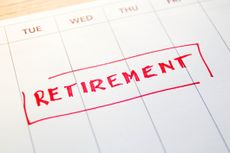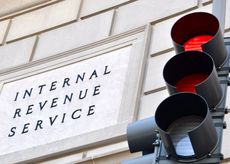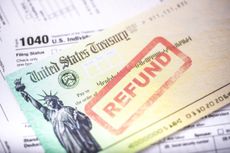The One Simple Move Keeping Americans From Getting Bigger Tax Refunds This Year
Many taxpayers are worried about getting smaller tax refunds this year (or owing tax on April 15 for the first time). If that happens to you, it might be because your withholding was too low last year.


Take a vacation? Pay off bills? Buy a new car? If you’re thinking of ways to spend this year’s tax refund before filing your return … wait! Trying to predict how much you’ll get back (or pay in) this year is extremely difficult. Plus, even if your overall tax bill goes down under the new tax law, this year’s refund check (if you even get one) might be smaller than what you’re used to getting. If you fall into that category, there’s a good chance it’s because your employer didn’t withhold enough tax from your 2018 paychecks.
Smaller and Fewer Refunds So Far
Data from the IRS’s first two weeks of processing returns shows smaller and fewer refunds this filing season when compared to totals from the same point last year. This year, the average refund for the first two weeks of the filing season is down 8.7% — from $2,135 last year to $1,949 this year. The percentage of processed returns with a refund during this year’s first two weeks also dropped — from 45.0% to 42.2%.
However, even though overall refund amounts are expected to be lower this year, it’s still too early to tell how much smaller the average refund for the entire filing season will be when compared to the average at the end of last year’s filing season ($2,943). Pete Isberg, head of government relations for payroll processor ADP, also notes that this year’s average will most likely spike once refunds for people claiming the earned income tax credit and additional child tax credit are issued. (Refunds for taxpayers claiming those credits won’t be available until February 27.) So don’t get fixated on the $1,949 week-two average.

Sign up for Kiplinger’s Free E-Newsletters
Profit and prosper with the best of expert advice on investing, taxes, retirement, personal finance and more - straight to your e-mail.
Profit and prosper with the best of expert advice - straight to your e-mail.
Did You Have Enough Tax Withheld?
There’s one thing we know for sure: One simple reason that many Americans’ refunds won’t be as large as expected (if they get a refund at all this year) is because the IRS changed the 2018 withholding rates so less money was generally taken from each paycheck last year.
If you like getting a refund (or want a bigger refund than you got this year), it’s easy to adjust your withholding so more money is taken from your 2019 paychecks.
Historically, about 75% of wage earners get a refund, but the IRS said it wanted to bring taxpayers’ withholding closer to their actual tax liability to reduce that percentage. So if you didn’t adjust your withholding (more on how to do that in a minute), there’s good news and bad news. The good news is that you likely got bigger paychecks in 2018. The bad news is that the odds of getting a smaller refund or having to pay when you file your return went up.
This is the case for most workers, according to Isberg. ADP data shows that the number of withholding allowances claimed per employee stayed fairly constant from 2017 to 2018. That means most employees didn’t adjust their withholding. For example, only about 1% of Home Depot employees adjusted the number of their withholding allowances in 2018. Under the new withholding tables, employees who didn’t make a change to their 2018 withholding could be surprised by lower refunds than they’re expecting … or by having to send in a check to the IRS with their return for the first time.
Adjust Your Tax Withholding Now
There’s nothing you can do at this point to fix your 2018 withholding. But if you like getting a refund (or want a bigger refund than you got this year), it’s easy to adjust your withholding so more money is taken from your 2019 paychecks … if you're willing to make that sacrifice.
First, use the IRS’s Tax Withholding Estimator to estimate your 2019 tax liability and total withholding. Then, if you want to adjust your withholding to increase the income tax taken from each paycheck, simply submit a new Form W-4 to your employer. The withholding calculator will provide you with information that will help you fill out the form.
Of course, if you do get a big refund this year, you can also submit a new W-4 to decrease the amount of tax withheld each pay period in 2019, so your total withholding for the year roughly equals your estimated tax. (That’s what we recommend.) You won’t get a fat refund check next spring to pay for a vacation or a new car. But that’s OK — there’ll be more money in your pocket, not Uncle Sam’s, throughout the year. Why give the IRS an interest-free loan each pay period when you can keep that money for yourself?
Get Kiplinger Today newsletter — free
Profit and prosper with the best of Kiplinger's advice on investing, taxes, retirement, personal finance and much more. Delivered daily. Enter your email in the box and click Sign Me Up.
Rocky Mengle was a Senior Tax Editor for Kiplinger from October 2018 to January 2023 with more than 20 years of experience covering federal and state tax developments. Before coming to Kiplinger, Rocky worked for Wolters Kluwer Tax & Accounting, and Kleinrock Publishing, where he provided breaking news and guidance for CPAs, tax attorneys, and other tax professionals. He has also been quoted as an expert by USA Today, Forbes, U.S. News & World Report, Reuters, Accounting Today, and other media outlets. Rocky holds a law degree from the University of Connecticut and a B.A. in History from Salisbury University.
-
 M&A Is Why UnitedHealth Group Stock Is in of the 100,000% Return Club
M&A Is Why UnitedHealth Group Stock Is in of the 100,000% Return ClubUnitedHealth has given a master class in mergers and acquisitions over the years.
By Louis Navellier Published
-
 How GLP-1 Drugs Could Revolutionize Retirement
How GLP-1 Drugs Could Revolutionize RetirementGLP-1 drugs like Ozempic and Wegovy are already changing the way we age and manage chronic conditions.
By Jacob Schroeder Published
-
 Early Tax Refund Options Could Trap Your Cash
Early Tax Refund Options Could Trap Your CashTax Refunds Don’t be fooled into thinking you’re not getting a loan — because you really are.
By Kate Schubel Published
-
 First-Time Filing Taxes? Key Tax Tips to Know for 2025
First-Time Filing Taxes? Key Tax Tips to Know for 2025Tax Filing Preparing your IRS taxes for the first time may seem daunting, but here are some return preparation and filing tips to start.
By Kate Schubel Last updated
-
 Legislation Cracking Down on IRS Tax Refund Mail Theft Advances
Legislation Cracking Down on IRS Tax Refund Mail Theft AdvancesIRS A string of bipartisan measures targeting taxpayer refunds, rights, and protections move forward on Capitol Hill.
By Gabriella Cruz-Martínez Published
-
 Ten IRS Audit Red Flags for Retirees in 2025
Ten IRS Audit Red Flags for Retirees in 2025Retirement Taxes Retirees who think they can escape the IRS audit machine should think again.
By Joy Taylor Published
-
 Could ERC Delays Get Worse if Trump Downsizes the IRS?
Could ERC Delays Get Worse if Trump Downsizes the IRS?IRS The Trump administration’s push to shave down the IRS can impact taxpayers like you.
By Gabriella Cruz-Martínez Published
-
 IRS Income Tax Refund Schedule 2025: When Will Your Refund Arrive?
IRS Income Tax Refund Schedule 2025: When Will Your Refund Arrive?Tax Refunds Your 2025 IRS tax refund may arrive sooner than you think. Here’s a schedule for when you can expect your check or direct deposit.
By Kate Schubel Published
-
 IRS Tax Refunds Are $526 Bigger This Year: Here's Why
IRS Tax Refunds Are $526 Bigger This Year: Here's WhyTax Refunds Inflation-related changes to the tax code could result in a larger refund.
By Gabriella Cruz-Martínez Published
-
 Ten IRS Audit Red Flags for Self-Employed Individuals
Ten IRS Audit Red Flags for Self-Employed IndividualsIRS Audits Taxpayers who file Schedule C with their Form 1040 have a greater chance of an IRS audit.
By Joy Taylor Published